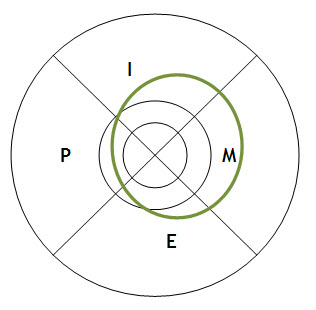It is important to note that the area of achievement (C – marked in red in the previous blog) is more complex than initially shown. It is in fact a composite of interaction at two levels. First there is an area of achievement that represents the person’s contribution to well being: what they produce, what they give, what they share with others. There is a second area: what they get from society, be it material, emotional and so on. Of course one would assume they are additive and that can be the case. I enjoy my work. In the process of work I both hope I create benefit for others; I do definitely benefit myself. But the process can also be negative: a person can have constraints placed upon their ability to achieve, whether by law, lack of resources, failure to learn, lack of support, or sheer lack of purpose (the apparently brilliant person who simply wastes their talent for reason of having no idea how to focus it on anything). I won’t explore this aspect of constraint now. I mention it to make clear that the area of achievement is more complex than a matter of totting up a scorecard. The area of achievement is the combination of what are in effect outward and inward flows resulting in a compromise result.
The following diagrams illustrate this for the moment:

Here the red area is the person’s own desired achievement. But society pulls the person in quite different ways. This person clearly seeks intellectual achievement: society (the blue area) pulls them in the direction of material well being. This might be the academic who goes to the City. And it is clear that this person’s family attaches emotional reward to that material success. Neither society or the individual themselves is giving sufficient attention to the person’s purpose: they are in poverty here in both diagrams.
Combine the tw0 and you get an area of actual achievement something like this:

The intellectual achievement of this person has been muted: their material success enhanced. Their own conflict at the consequence reduces their emotional sense of well-being: they cannot respond to the input they receive because that input from others demands of them a response they cannot wholeheartedly give. They remain confused as to their purpose, and at risk in this area of feeling meaningless. The resulting conflict that means they neither achieve what they desire or what others desire of them, and as such actually overall are diminished in the benefit they secure from what they do compared to either input position might reflect that lack of purpose.
The key point is, once again, that balance is better. If those surrounding an individual can enhance what the individual has to offer and encourage it to flourish they will clearly be better off. If they (individually and collectively) cannot do that then the outcome detracts from the individual’s well-being. That may be obvious. I suggest the diagrams help make it clear.

2 Responses to “Inputs and outputs: best in balance”